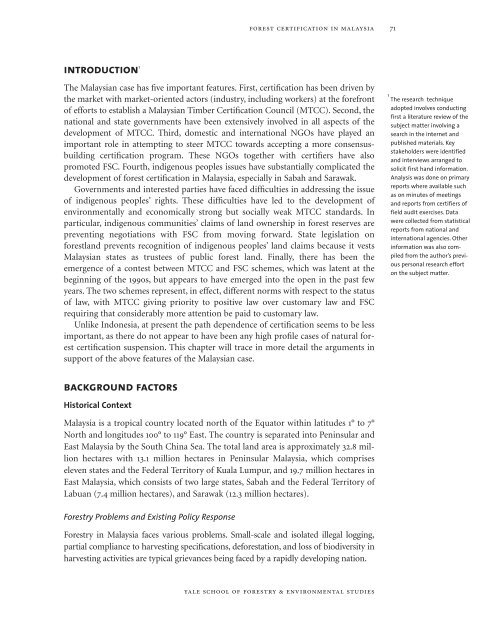Forest Certification in Malaysia - Yale University
Forest Certification in Malaysia - Yale University
Forest Certification in Malaysia - Yale University
Create successful ePaper yourself
Turn your PDF publications into a flip-book with our unique Google optimized e-Paper software.
forest certification <strong>in</strong> malaysia<br />
71<br />
<strong>in</strong>troduction 1<br />
The <strong>Malaysia</strong>n case has five important features. First, certification has been driven by<br />
the market with market-oriented actors (<strong>in</strong>dustry, <strong>in</strong>clud<strong>in</strong>g workers) at the forefront<br />
of efforts to establish a <strong>Malaysia</strong>n Timber <strong>Certification</strong> Council (MTCC). Second, the<br />
national and state governments have been extensively <strong>in</strong>volved <strong>in</strong> all aspects of the<br />
development of MTCC. Third, domestic and <strong>in</strong>ternational NGOs have played an<br />
important role <strong>in</strong> attempt<strong>in</strong>g to steer MTCC towards accept<strong>in</strong>g a more consensusbuild<strong>in</strong>g<br />
certification program. These NGOs together with certifiers have also<br />
promoted FSC. Fourth, <strong>in</strong>digenous peoples issues have substantially complicated the<br />
development of forest certification <strong>in</strong> <strong>Malaysia</strong>, especially <strong>in</strong> Sabah and Sarawak.<br />
Governments and <strong>in</strong>terested parties have faced difficulties <strong>in</strong> address<strong>in</strong>g the issue<br />
of <strong>in</strong>digenous peoples’ rights. These difficulties have led to the development of<br />
environmentally and economically strong but socially weak MTCC standards. In<br />
particular, <strong>in</strong>digenous communities’ claims of land ownership <strong>in</strong> forest reserves are<br />
prevent<strong>in</strong>g negotiations with FSC from mov<strong>in</strong>g forward. State legislation on<br />
forestland prevents recognition of <strong>in</strong>digenous peoples’ land claims because it vests<br />
<strong>Malaysia</strong>n states as trustees of public forest land. F<strong>in</strong>ally, there has been the<br />
emergence of a contest between MTCC and FSC schemes, which was latent at the<br />
beg<strong>in</strong>n<strong>in</strong>g of the 1990s, but appears to have emerged <strong>in</strong>to the open <strong>in</strong> the past few<br />
years. The two schemes represent, <strong>in</strong> effect, different norms with respect to the status<br />
of law, with MTCC giv<strong>in</strong>g priority to positive law over customary law and FSC<br />
requir<strong>in</strong>g that considerably more attention be paid to customary law.<br />
Unlike Indonesia, at present the path dependence of certification seems to be less<br />
important, as there do not appear to have been any high profile cases of natural forest<br />
certification suspension. This chapter will trace <strong>in</strong> more detail the arguments <strong>in</strong><br />
support of the above features of the <strong>Malaysia</strong>n case.<br />
1 The research technique<br />
adopted <strong>in</strong>volves conduct<strong>in</strong>g<br />
first a literature review of the<br />
subject matter <strong>in</strong>volv<strong>in</strong>g a<br />
search <strong>in</strong> the <strong>in</strong>ternet and<br />
published materials. Key<br />
stakeholders were identified<br />
and <strong>in</strong>terviews arranged to<br />
solicit first hand <strong>in</strong>formation.<br />
Analysis was done on primary<br />
reports where available such<br />
as on m<strong>in</strong>utes of meet<strong>in</strong>gs<br />
and reports from certifiers of<br />
field audit exercises. Data<br />
were collected from statistical<br />
reports from national and<br />
<strong>in</strong>ternational agencies. Other<br />
<strong>in</strong>formation was also compiled<br />
from the author’s previous<br />
personal research effort<br />
on the subject matter.<br />
background factors<br />
Historical Context<br />
<strong>Malaysia</strong> is a tropical country located north of the Equator with<strong>in</strong> latitudes 1° to 7°<br />
North and longitudes 100° to 119° East. The country is separated <strong>in</strong>to Pen<strong>in</strong>sular and<br />
East <strong>Malaysia</strong> by the South Ch<strong>in</strong>a Sea. The total land area is approximately 32.8 million<br />
hectares with 13.1 million hectares <strong>in</strong> Pen<strong>in</strong>sular <strong>Malaysia</strong>, which comprises<br />
eleven states and the Federal Territory of Kuala Lumpur, and 19.7 million hectares <strong>in</strong><br />
East <strong>Malaysia</strong>, which consists of two large states, Sabah and the Federal Territory of<br />
Labuan (7.4 million hectares), and Sarawak (12.3 million hectares).<br />
<strong>Forest</strong>ry Problems and Exist<strong>in</strong>g Policy Response<br />
<strong>Forest</strong>ry <strong>in</strong> <strong>Malaysia</strong> faces various problems. Small-scale and isolated illegal logg<strong>in</strong>g,<br />
partial compliance to harvest<strong>in</strong>g specifications, deforestation, and loss of biodiversity <strong>in</strong><br />
harvest<strong>in</strong>g activities are typical grievances be<strong>in</strong>g faced by a rapidly develop<strong>in</strong>g nation.<br />
yale school of forestry & environmental studies
















